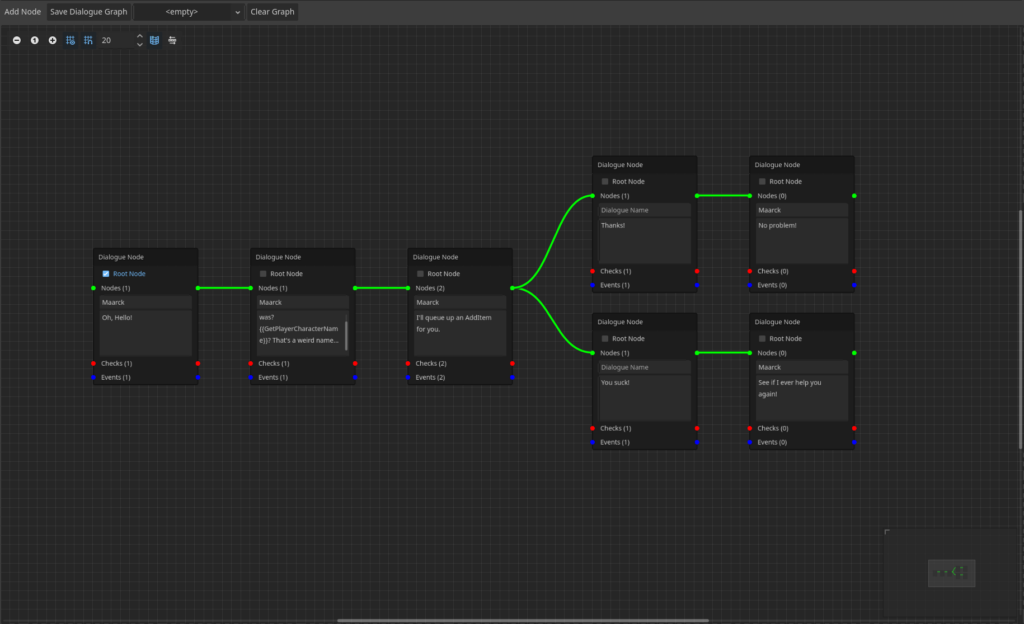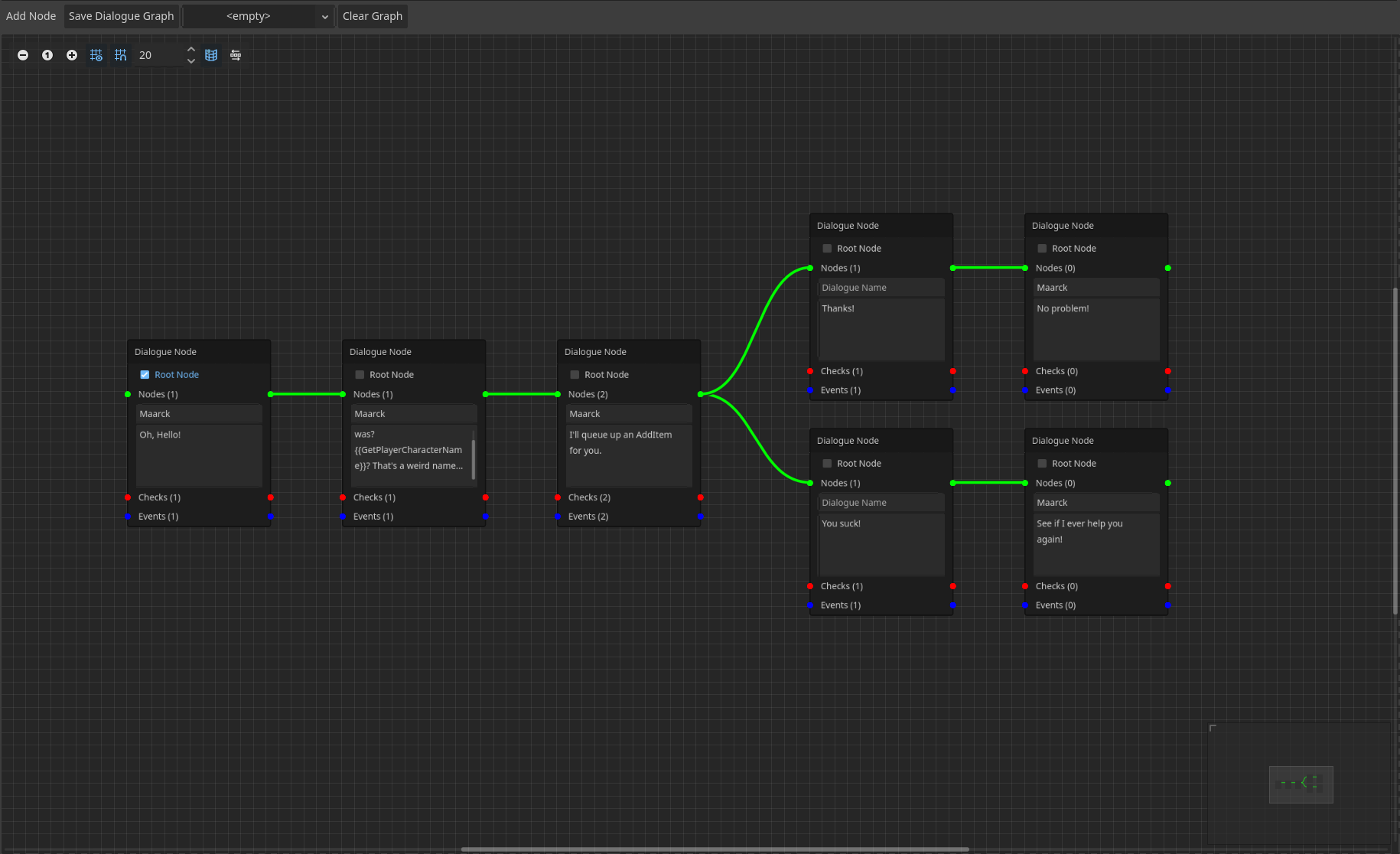After having gone through the journey that was re-deciding to work with Godot, it was time to start moving forward again. And holy fuck this was quite a day. I haven’t really doubled down, I’ve like… tripled down.
The next step was, I came to believe, making the server the authority over items.
See, when you get an item in an MMO, the client reaches out to the server and says “Hey, someone’s giving me this item. Just wanted to let you know.”
The server does a bunch of checks to make sure you’re in the right place to get that item, that you know the right people, that you have enough money if you’re buying it, that kind of thing.
If the server says “Hey whoa, no, you can’t have that, you cheater!” then the client drops it like its hot and the item goes away. But if the server says “Yeah everything looks good on my end,” then the client pockets the item, trusting that the server has already persisted it in a database.
The same is true with using items. If you use an item on a player, the client says “Hey, my guy wants to use this item on this player,” and then the server checks to see if you’ve got the item, if you’re close enough to use it, if it even can be used, and then replies with a yes or no.
My server is actually already doing the second part… but it’s not doing the first part. I have to hack items in every time I want to test them.
See, I did that because currently the only way to get an item in the game is through the NPC dialogue… But the server has no idea when you enter a dialogue, who you’re entering it with, if you have the appropriate progression to speak with that person, etc.
Sound familiar? Yeah, the server should be the authority for dialogues too… which presents a bit of a challenge.
The Challenge
The current dialogue library I’m using is good. It’s great, even. It’s so easy to use, it’s very fully featured, and it was essentially plug-and-play.
It has… exactly one big limitation.
And that’s that, outside of actually displaying the text on the screen, there’s no way to traverse through the lines of dialogue in code.
Why would you want to do that?
So here’s the thing… If you start talking to a guy, and if you don’t have a Hi-Potion in your inventory, he says “Get me a Hi-Potion” but if you do have a Hi-Potion in your inventory, he says “Give me that Hi-Potion”, and then you can either choose to give it to him or not give it to him … that’s a bunch of branches. And some of those branches have conditions – you shouldn’t be able to give the guy a Hi-Potion if you don’t have a Hi-Potion.
And as we’ve already laid out, the server is the authority over whether you have, or can give away, an item. Because otherwise people could cheat.
So what essentially needs to happen is that when you start a dialogue, the server pretends to start it too. When you advance a dialogue, the server pretends to advance it too. When you come to a choice, and you pick an option, the server pretends to pick it too – and in so doing, validates that you actually qualify for the choice you’re picking. If you choose to give the guy a Hi-Potion, the server can do it too – and again, make all the checks it needs to make.
There is currently no possible way to do that in the library I’ve downloaded to manage dialogue. It’s too difficult for me to learn the whole library, which is written in another language, and desperately hope I can make something work.
And honestly, I’ve already looked into it, and I just don’t think it would be a good use of my time. It’s specifically designed to be lightweight and easy to use. Unfortunately for me, that means it’s also difficult to extend.
The Upshot
There’s good news, though. Before I even chose this library, I initially wanted to bring over my old home-grown dialogue system from an old attempt I made at making a game.
I remembered loving that dialogue system because it had a cool graphical editor, and it did all the neat tricks I wanted it to do, but it was also deadass simple to use.
It was one of the things I was most proud of ever having written in my life. So I tried to port it from Unity into Godot, and …. it was a massive failure.
One of the biggest things holding me back is that Godot’s graph-based editor is …….. how do I put this delicately?
A steaming pile of microplastic-filled shit.
So I abandoned it and just downloaded the library.
But now that I’m back in Godot land and I’m committing to using Godot, I knew I needed another solution for dialogue. The current library, to be frank, wasn’t going to cut it.
So I took another look at my existing library and realized… well shit. It’s already in the perfect shape. The client can traverse the lines, checks, and events for real, and the server can pretend to traverse them while it checks to make sure everything’s okay.
It’s literally exactly how it needs to be already. Yet another reason why this beautiful code is one of the best things I’ve ever written.
So I spent……. 16 hours…. fighting… bashing… carressing… and then headbutting Godot’s graph editor into submission.
This is not done yet, not by a long shot, but I’ve ended the day with something, and I have a very clear path to victory now. It will work. I’ve proven that it will work. I can see it working already. Now it’s just going to be a lot of time, and a lot of elbow grease.

To answer the logical question that might come up, yes the branches can converge, they can repeat, they can cross, they can circle back on themselves. They can do whatever you want them to do. Because it’s so. god. damn. cool.
And y’all know I never talk about my own work like that.

